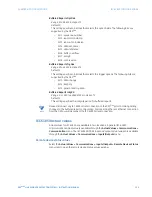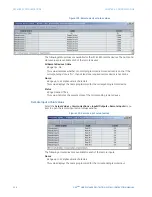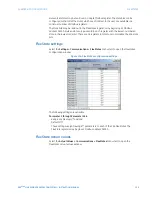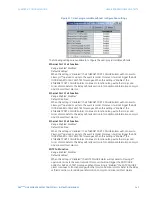
CHAPTER 6: COMMUNICATIONS
DIRECT INPUTS AND OUTPUTS
D90
PLUS
LINE DISTANCE PROTECTION SYSTEM – INSTRUCTION MANUAL
145
Figure 118: Serial port configuration settings
The following settings are available to configure the RS485 port.
Baud Rate
Range: 300, 600, 1200, 2400, 4800, 9600, 19200, 38400, 57600, 115200
Default: 19200
This setting specifies the baud rate (bits per second) for the RS485 port.
Parity
Range: None, Odd, Even
Default: None
This setting specifies the parity for the RS485 port.
Minimum Response Time
Range: 0 to 1000 ms in steps of 10
Default: 0 ms
The minimum time before the port will transmit after receiving data from a host can be
set. This allows operation with hosts which hold the RS485 transmitter active for some
time after each transmission.
Connection
Range: Local, Remote
Default: Local
This setting selects whether the serial RS485 connection is classified as local access or
remote access for security purposes.
Direct inputs and outputs
Direct inputs and outputs are available if an inter-relay communications card is installed.
Direct inputs and outputs provide a means of sharing digital point states between a
number of UR
Plus
-series or UR-series IEDs over a dedicated fiber, RS422, or G.703 interface.
No additional switching equipment is required as the IEDs are connected directly in a ring
or redundant (dual) ring configuration. This feature is optimized for speed and intended for
pilot-aided schemes, distributed logic applications, or the extension of the input/output
capabilities of a single device.
The D90
Plus
provides 96 direct inputs and 96 direct outputs per communications channel.
Direct inputs and outputs are intended for exchange of status information (inputs and
outputs) between UR
Plus
-series devices connected directly via inter-relay communications
cards. The mechanism is very similar to IEC 61850 GSSE, except that communications
takes place over a non-switchable isolated network and is optimized for speed. All inter-
relay communication cards support two channels, allowing direct output messages to be
sent from both channels simultaneously. This effectively sends direct output messages
both ways around a ring configuration. Messages will be resent (forwarded) when it is
determined that the message did not originate at the receiver.














































